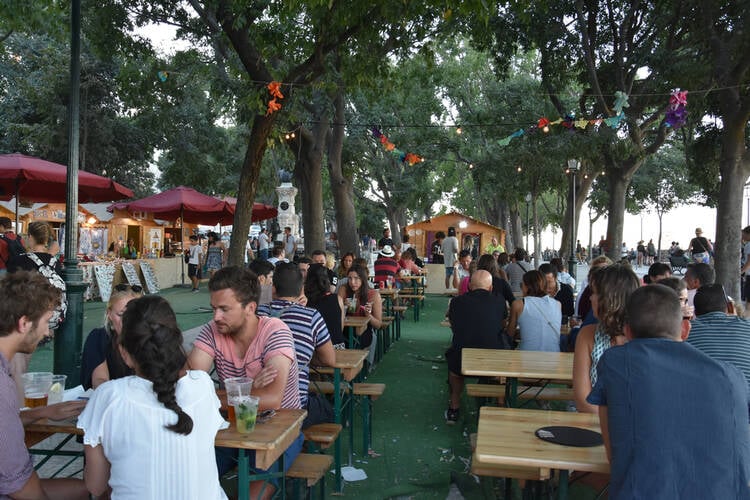
The average beer garden business in the U.S. generates approximately $300,000 to $1 million in annual revenue, depending on location, size, and customer traffic.
However, several factors influence how much a beer garden can make yearly.
These include the size of the garden, the variety of beers and food offered, location, licensing costs, marketing efforts, seasonal variations, and the presence of entertainment or live music.
If you have traveled across the United States especially in states like Texas, California, and Florida, you have likely come across vibrant beer gardens. The truth is, beer gardens are profitable ventures.
Profit Margin of a Beer Garden Business
The profit margin of a beer garden business in the U.S. typically ranges between 15% and 30%, depending on location, operating costs, and customer volume.
Note that in order to maximize the profit margin of your beer garden business, you must be willing to control overhead costs, source beverages and food at competitive prices, and maintain efficient staffing.
Apart from that, offering high-margin items like house brews, signature cocktails, and event bookings can boost profitability.
Consistent marketing, quality customer service, and seasonal adaptations are also essential.
Over and above, a well-managed beer garden with strategic pricing and operations can achieve strong, sustainable profits year-round.
Factors That Influence the Income of a Beer Garden Business
-
Location of the Beer Garden
Urban areas or tourist-heavy cities generally see more foot traffic and offer greater potential for higher sales compared to rural locations.
A beer garden situated near busy streets, entertainment hubs, or college campuses is more likely to attract consistent crowds.
Accessibility, visibility, parking availability, and proximity to public transport also matter.
Of course, regions with favorable weather allow for year-round operation, while colder climates may limit seasonal revenue.
Choosing a strategic, high-traffic, and weather-friendly location can significantly boost a beer garden’s annual income.
-
Size and Seating Capacity
Larger beer gardens with ample outdoor and indoor seating can accommodate more guests at any given time, especially during peak hours and events. This allows for higher customer turnover and increased sales volume.
Beer gardens with flexible space to host private parties, group gatherings, and live events can further maximize profits.
Investing in a well-planned layout ensures efficient space utilization and improved revenue potential.
-
Menu Variety (Beer and Food)
Beer gardens that serve a variety of local craft beers, international brews, seasonal selections, and specialty drinks tend to attract a broader customer base.
Pairing drinks with a well-curated food menu such as pretzels, sausages, burgers, or charcuterie boards enhances the customer experience and increases average spend per visit.
Limited or repetitive options can discourage repeat customers. Furthermore, including vegetarian, vegan, or gluten-free choices can widen appeal.
Offering tasting flights, pairing events, and rotating specials can drive customer interest and boost yearly revenue significantly.
-
Licensing and Permits
A comprehensive license allowing for on-site beer and wine sales, extended operating hours, and live entertainment can create more revenue opportunities.
Conversely, restrictive or expensive licenses may limit service capabilities or profit margins.
Local zoning laws, noise ordinances, and health regulations must also be met, potentially requiring investment in infrastructure or ongoing compliance costs.
Navigating these regulations carefully is essential. While licenses are an upfront and ongoing cost, obtaining the right ones legally enables maximum operational potential and long-term profitability.
-
Marketing and Brand Visibility
A beer garden’s ability to consistently attract customers depends on its marketing strategy and brand visibility.
Businesses that invest in social media advertising, email campaigns, influencer partnerships, and community engagement typically see stronger brand recognition and customer loyalty.
A compelling brand story, engaging visuals, and a memorable name or logo help distinguish the beer garden from competitors.
Seasonal promotions, special events, and loyalty programs also improve customer retention.
Poor or inconsistent marketing can result in low foot traffic and missed revenue.
-
Entertainment and Events
These experiences create a sense of community and encourage customers to stay longer and spend more.
Special events often attract new guests, boost sales of premium drinks, and increase table turnover.
Booking local bands or hosting holiday-themed nights adds vibrancy and keeps the venue top-of-mind.
Furthermore, private event bookings like birthdays or corporate gatherings bring in high-margin revenue. Without entertainment, a beer garden may struggle to differentiate itself.
-
Seasonal Variability
In regions with harsh winters or long rainy seasons, outdoor seating may be unusable for extended periods, causing dips in revenue.
Conversely, beer gardens in mild or warm climates can operate consistently year-round.
Some beer gardens address this by installing heating, covered patios, or transitioning to indoor spaces during colder months.
Seasonal menus, themed events, or festivals like Oktoberfest can help maintain momentum.
Understanding seasonal patterns and adapting accordingly is essential to maximizing income across all months, not just peak summer periods.
-
Staffing and Customer Service
Friendly, knowledgeable, and efficient staff can enhance the customer experience, encouraging longer stays and higher spending. In contrast, poor service can lead to negative reviews and lost revenue.
Investing in employee training, fair wages, and incentive programs improves morale and performance.
During busy seasons, adequate staffing levels ensure smooth operations and reduced wait times. Understaffing, on the other hand, can create bottlenecks and impact sales.
-
Operational Hours
Longer hours, including evenings and weekends, offer more opportunities to serve customers and increase revenue.
Opening during lunch hours can attract local workers, while late-night service appeals to the nightlife crowd.
However, extended hours come with increased labor, utility, and security costs.
It’s important to align operating hours with customer demand and local regulations.
Strategic scheduling, including seasonal adjustments, can help optimize staff workload and profits.
-
Community Engagement and Local Partnerships
Beer gardens that actively engage with their local community often see increased support and business.
Collaborating with local breweries, food trucks, musicians, or artists can create a unique and authentic atmosphere that draws in crowds.
Hosting charity events, participating in farmer’s markets, or supporting local sports teams can enhance brand reputation and visibility.
Community partnerships allow for co-promotion and shared customer bases. A strong local presence builds trust and generates word-of-mouth referrals.
Conversely, a lack of community involvement can make a beer garden seem disconnected or generic.
